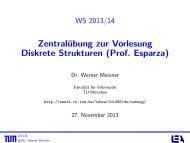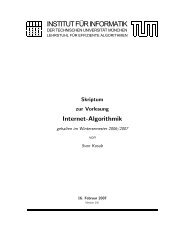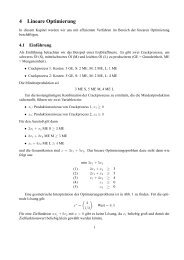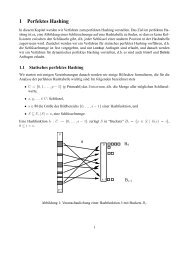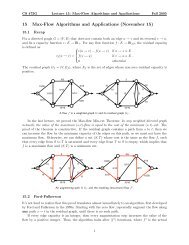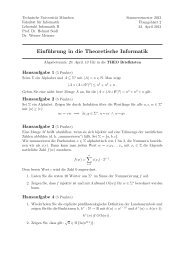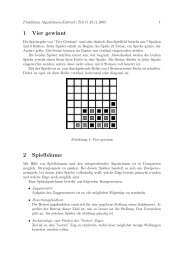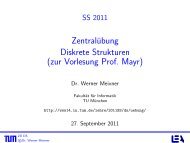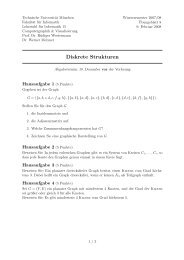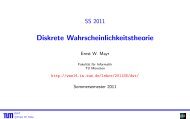ABCDE FGHIJ KLMNO
ABCDE FGHIJ KLMNO
ABCDE FGHIJ KLMNO
- No tags were found...
You also want an ePaper? Increase the reach of your titles
YUMPU automatically turns print PDFs into web optimized ePapers that Google loves.
TUM-INFO-06-I0821-0/1.-FIAlle Rechte vorbehaltenNachdruck auch auszugsweise verbotenc○2008Druck:Institut für Informatik derTechnischen Universität München
Binary Search on Two-Dimensional DataRiko JacobInstitut für Informatik, Technische Universität MünchenD-80290 MünchenAbstractWe consider the problem of searching for the predecessor (largest element that is smaller thansome key) among elements that are organized as a matrix such that every row and every columnis weakly monotonic (sorted matrix). The results are matching upper and lower bounds for thenumber of accesses to the matrix and comparisons with the key.Keywords: sorted matrix, binary searchACM Computing Classification System (1998): F.2.21 IntroductionIt is well known that the complexity of searching for the predecessor of some key in a set of size nheavily depends on how the set is organized: If it is sorted, it can be done in log n steps, if nothingis known about the set, it will take n steps. Here, we consider a setting where the set is organizedin a matrix (two dimensional array) such that each column and each row is sorted. A generalizationof such matrices are known in the literature as “Young Tableaux”, and there is a rich literature onthe topic, see for example the textbook by Fulton [2]. Usually, such tableaux are used to representelements of an algebra, and the interest is in the structure of some operations acting on the tableaux.In contrast, here we are considering a single tableau in which we search a predecessor as efficientlyas we can.This questions originates in the work of Matthias Altenhoefer and Sven Oliver Krumke in thecontext of parametrized search for flow computations. There, an access to the oracle corresponds to amax-flow computation on G, and the matrix has one row and column per edge of G.A variant of the problem, where oracle questions are cheap (as expensive as matrix accesses) hasbeen considered in [1].1.1 SettingHere, we assume that the entries of the matrix stem from an ordered universe, and that the onlyoperation allowed on such elements is the comparison. The indices necessary to describe positions ofthe matrix are natural numbers. We assume that such numbers (up to n · m, the size of the matrix) canbe added and compared at unit cost.We count the indexed accesses to the matrix separately. Further, comparisons involving the elementfor which we search the predecessor are counted as oracle questions.1
Monotone Matrix SearchGiven A real (totally ordered universe) m × n matrix A, where the values are sorted within a columnand sorted within a row. More precisely, we have that i ≤ i ′ and j ≤ j ′ implies a ij ≤ a i ′ j ′.A monotone oracle B; internally, B contains a value b, and a question a to the oracle gives theyes/no answer to a < bOutput A largest entry of A for which the oracle answers yes, i.e., an a ij ≤ b such that no a i ′ j ′ existswith a ij < a i ′ j ′ < b.One algorithm to solve a Monotone Matrix Oracle is the following: Sort the n · m entries of thematrix A in time O(nm log nm), then use the oracle B to perform a binary search. This algorithmaccesses n · m elements of the matrix, and uses the oracle ⌈log n · m⌉ times. In the following, wewant to reduce the number of accesses to the matrix without significantly increasing the number ofquestions to the oracle.semi-Monotone Matrix Search is an Monotone Matrix Search, where only the columns are sorted.Here it is convenient to allow different sized columns (there is no connection between columns anyway).In that situation the vector (m 1 , . . . , m n ) gives the size (length) of the different columns.f, l Matrix Oracle An n × n Matrix given by a ij = (f + il)/j. After mirroring around a verticalaxis, this matrix is strictly monotone in the above sense.2 Auxiliary Algorithms2.1 Weighted MedianThe following result appeared in [3].weighted medianGiven n pairs (a i , w i )Output a such that for N = ∑ i w i we haveand∑w i ≤ N/2i:a i aLemma 1 weighted median can be computed in O(n) time (assuming addition to be constant time).Proof. Find the unweighted median in O(n) time. Check if it is too big or to small in linear time.Recurse with updated weight demand.⊓⊔2
3 Lower Bounds3.1 OracleLemma 2 For every n, m, there is a Monotone Matrix Search matrix A such that for every algorithmthere exists an oracle that is queried at least log n + log m many times.Proof. Consider the matrix A with the entries a ij = i · n + j. Now, all the n · m different outcomespossible, depending on the oracle. The questions to the oracle that an algorithm asks on A gives riseto a binary decision tree, where each leaf is labeled with an entry of A. Hence, there must be n · mleafs, which is impossible if the algorithm asks always less than log n + log m questions. ⊓⊔3.2 Matrix AccessAntichainLemma 3 There exists a n × n Monotone Matrix Search A such that any algorithm must access atleast n entries.Proof. Define M = n 2 + 2. Consider the matrix A with entries a ij = i · n + j if j < n − i,a ij = 2M + i · n + j if j > n − i, and a i,(n−i) = x i = M + i. Take an oracle with value M. Thismatrix is clearly Monotone Matrix Search, and the correct answer is a n−1,1 < M − 1. Now, if analgorithm does not access one of the positions on the secondary diagonal, one of the values x i is notread. Hence, the matrix A ′ that is like A and only x i is changed to M − 1, will lead the algorithm tothe wrong answer. Any algorithm must access at least all the n elements on the secondary diagonalof A.⊓⊔semi-Monotone Matrix SearchLemma 4 A semi-Monotone Matrix Search with chain-length m 1 , . . . , m n requires ∑ ni=1 (1+log m i)accesses to the matrix by a deterministic algorithm in the worst case.Proof. Consider the following game where the oracle is fixed to 0 (and may be accessed by thealgorithm without cost). The algorithm and the adversary take turns. The algorithm points at aposition, the adversary announces some value for this position. With m = max{m 1 , . . . , m n }, theadversary may use integers in [−m, m]. The goal of the algorithm is to find in each column theposition of the smallest positive number. The number of alternations the adversary can enforce givesa lower bound on the worst case number of accesses to the matrix by the algorithm.The strategy of the adversary is the following: It “fills in” consecutive negative numbers from thebottom and consecutive numbers from the top. Initially, it places −(m + 1) below, and m + 1 above.Now, if the algorithm asks a position that is not yet filled in, the adversary has the choice (withinits self-given framework), to either extend the positive numbers or the negative numbers. It chooseswhatever leaves more spaces open. Hence, the algorithm can at best force the adversary to reduce thenumber of open positions from m ′ to ⌈(m ′ − 1)/2⌉.Hence, the biggest m(i) for which an algorithm can get away with i questions is given by therecursion m(1) = 1, m(i + 1) = 2m(i) + 1, which has the solution m(i) = 2 i − 1. From this thestatement of the lemma follows.⊓⊔3
Using Yao’s Minimax-principle [5, 4, p. 35], Lemma 4 shows that the worst case running time cannotbe improved by using randomization. This principle (together with some standard considerations)show that Lemma 4 remains valid for the expected execution time.non-square Monotone Matrix SearchLemma 5 An n × m Monotone Matrix Searchwith m ≥ n requires n log ⌊m/n⌋ accesses to thematrix.Proof. If m < 2n there is nothing to be shown. Otherwise, there is a secondary diagonal consistingof n pieces, each ⌊m/n⌋ positions long, pieces non-overlapping. Place −∞ in the positions belowthis, +∞ above. On the diagonal, embed an arbitrary n × ⌊m/n⌋ semi-Monotone Matrix Search. ByLemma 4 the statement of the lemma follows.⊓⊔4 Monotone Matrix Search Algorithms4.1 Algorithm 0 / Optimizing Matrix Accesses onlyThe following algorithm can be understood as a variant of one of the algorithms in [1].Consider the situation of a square matrix A and n = 2 k − 1. Hence, there are k natural submatricesA i , given by both indices being divisible by 2 k−i for i ∈ {1, . . . , k}. We generalize the task inthe following way: Instead of asking only for the largest element for which the oracle answers yes,we want in every row and in every column this element (in case of ties, the one with largest index).Actually, this is equivalent to finding the correct position of b in each row and each column. Now,assume this knowledge is already available for the submatrix of level i, and we want to create it forlevel i+1. To this end, we only need to access elements that could still be this boundary. Observe thatevery new element either is in an old row or column and has two old horizontal and vertical neighbors,or has two old diagonal neighbors. Because old rows, columns and diagonals are ordered and therethe boundary is known, there can be at most one new element per old row, column, and diagonal.Hence there are at most 2 i + 2 i + 2 · 2 i = 4 · 2 i new elements to be accessed and tested in this round.Hence, this algorithm accesses in total ∑ ki=1 4 · 2i = 4 · (2 k+1 − 1) ≤ 8n out of the n 2 elements ofthe matrix.The number of questions to the oracle can be kept at k 2 = log 2 n by not asking every elementindividually. Instead, we collect all new elements of the matrix of one round, sort them, and performa binary search on this list. Then, all necessary answers of the oracle can be deduced. The O(n log n)computation time of this step can be improved to O(n) by replacing the sorting with repeated medianfinding.4.2 semi-Monotone Matrix SearchConsidering the columns of a semi-Monotone Matrix Search as individual tasks, it can certainly besolved with n log m oracle questions and matrix accesses. A first improvement is to proceed in rounds,where each column contributes with the current median of the remaining possible answers. Again,instead of asking all n oracle questions, the n values are sorted and a binary search with the oracle isperformed, yielding all n answers. The total number of questions to the oracle is now log n · log m.4
The following algorithm reduces this to O(log n + log m) questions to the oracle. The main ideais to let go the synchronization between the searches in the different columns. Then, in every column,at all times, the search can be characterized by 3 entries, namely the smallest one known to be largerthan b, the largest one known to be smaller than b, and the middle position between the two, theelement x i for which the comparison with b (the question to the oracle) is pending (unless the columnis finished). This identifies the number m i of elements in this column that are still potentially the rightanswer. Now, the median x of the x i weighed with m i is computed and is used to question the oracle.If the oracle answers “yes” (x < b) this makes progress for all searches with x i ≤ x, if the answeris “no” it makes progress for all searches with x i ≥ x. If a search makes progress, the number m iis halved. Because x is the weighted median, this progress happens for one half of the potentialoutcomes, and ∑ i m i is reduced by a factor 3/4. Hence, the number of rounds and oracle questionsis O(log(n · m)) = O(log n + log m), and the number of accessed matrix elements is O(n log m),which is optimal.4.3 square Monotone Matrix SearchNow, the ideas of Section 4.1 and 4.2 can be combined to an algorithm that on square MonotoneMatrix Searchs performs O(n) accesses to the matrix and O(log n) oracle questions.Observe that we can identify new elements to be accessed in the matrix (and to schedule to implicitlycheck with the oracle) as soon as its neighbors one level higher are identified to be on theboundary. Define for every element that is accessed in Algorithm 0 in level i its weight to be (2 k−i ) 2 .Similarly to Section 4.2, we keep a list of active nodes (for which the comparison with the oracle ispending), compute their weighted median, and query the oracle with this median. This resolves eitherall active nodes whose values are at least as large as the median, or at most as large as the median.If an element a of level i is resolved (implicitly compared to the oracle), it gives rise to at mostthree new elements on level i + 1, namely one for the row, one for the column, and one for thediagonal. Because the weight of one such element is one quarter of the weight of a, exchanging awith its three replacements (follow-ups), still reduces the weight of active nodes by one quarter ofthe weight of a. Hence, every question to the oracle reduces half the weight of the active nodes by afactor 3/4. Because initially there is one active node of weight n 2 , the total number of queries to theoracle is log 4/3 n 2 = O(log n).4.4 general Monotone Matrix SearchAssume w.l.o.g. n > m. Select n columns of A at distance roughly n/m, leading to the squaresubmatrix A ′ . Solve Monotone Matrix Search on A ′ , remembering the dividing line. Now, solve theremaining pieces of the rows as columns of a (transposed) semi-Monotone Matrix Search. In total,this gives O(log nm) questions to the oracle and O(n⌈log(n/m)⌉ accesses to the matrix (both termsdominated by the second part).4.5 f, l Matrix OracleFor the particularly structured case of a f, l Matrix Oracle, a simpler algorithm achieves O(n) matrixaccesses and O(log n) oracle queries, asymptotically matching the Monotone Matrix Search case. For5
Keep the invariant that for x 1 < x < x 2 we have z(x) < min{z(x 1 ), z(x 2 )}, and the analogstatement for x 2 , x 3 , y 1 , y 2 and y 2 , y 3 .Different Ls overlap only at the side where the boundary enters and leaves, there the dividinglines (given by x 1 and y 3 or y 1 and x 3 ) are shared with the neighboring L. More precisely,the positions (x i , y j ) are already compared to the oracle, such that the other boundaries arealready known to not contain further witnesses. Hence, the area for a lower L (turning right) is(x 3 − x 1 − .5) · (y 3 − y 1 − .5) − (x 3 − x 2 + .5) · (y 3 − y 2 + .5), an upper L analogously hasarea (x 3 − x 1 − .5) · (y 3 − y 1 − .5) − (x 2 − x 1 + .5) · (y 2 − y 1 + .5). It is allowed that (x 2 , y 2 )is the only witness of an L.Initially, there is one degenerated L consisting of the whole matrix; Assuming the dimensionsof the matrix to be powers of two by filling in +∞ or −∞, this satisfies the invariants about z(.)with x 1 = x 2 = y 1 = y 2 = 0, y 3 = n, x 3 = m.• In every refinement step of a region double precision, i.e., choose x 12 = (x 1 + x 2 )/2, i.e., thex-value with largest z(x) between x 1 and x 2 . Choose x 23 , y 12 , and y 23 analogously. This leadsto 5 × 5 new probe positions, of which 7 are not already implicitly compared to the oracle.Points on the boundary might already be clear by previous questions of other Ls, other pointsmight be clear by previous questions to the oracle. (All of this is ignored in the analysis.)• Access and sort the entries at the probe positions, build the binary tree of height 3 that modelsa binary search for b in the probes. Following a path in this tree, the current probe participatesin the median search (resulting in a question to the oracle) with weight (3/4) i 3 times the area ofthe original L, where i = {0, 1, 2} denotes the distance from the root in the binary search tree.• Once a leaf of the decision tree is reached, the grid inside the L-region is completely evaluated.One possibility is that the L just shrinks in width. By the choice of new lines, the invariants aremaintained.The other possibility is that three or more (always an odd number) of new L-shaped regions(possibly degenerated) come into existence. Observe that there are at most 4 rectangles in arow or column (inside the L). Hence, there are at most two consecutive non-corner rectangles,such that these rectangles can be attached to Ls. If there is one such rectangle, one (arbitrarily)of the Ls is degenerated. Hence, only neighboring x-values and y-values are used to define newLs. This maintains the invariant about z(.).5.2 AnalysisOracle questions Define γ = (3/4) 1 3 . The total virtual weight is the sum of the weights of elementsparticipating in the median selection. Note that this is one point from every L. At the very first step,there is only one degenerated L with weight nm. Note that an L with weight < 1 cannot containa point and has hence weight 0. Now, for every point that is implicitly answered by the oracle, thefollow up weight (virtual area, perhaps summed up) is at most the current multiplied by γ < 1: Duringthe binary search, this factor changes from γ j to γ j+1 , when the L is split from γ 2 to 3/4 = γ 3 or less.Hence, every oracle question reduces the remaining total virtual weight by (1 − γ)/2 > 0. Thefactor is τ = 1 − (1 − γ)/2, hence the task is finished after x oracle questions if the area is nmτ x < 1,log nm + x log τ < 0, x > − 1 log nm. Hence, at most 15 log nm oracle questions suffice.log τ7
Matrix accesses Assume m ≥ n. The following discussion assumes that p is a power of two.Consider running Algorithm 0. Annotate positions accessed by this algorithm with the round they areaccessed in. After for log n rounds, the resulting region where further witnesses must be consists ofpO(p) rectangles of size n × m , and the total number of accesses to the matrix is O(p).p pDefine the width of an L to be the smaller side of the corner-rectangle, i.e., for a right turning Lmin{x 2 − x 1 , y 2 − y 1 }, and the relative width v = min{ x 2−x 1, y 2−y 1}. If v > 1/p, then at least onem nof the probe positions of the adaptive algorithm has a level smaller than log p. Charge the constantlymany accesses of refining this L to the probe with this smallest annotation.Observe that the Ls used in the algorithm form a hierarchy (tree by inclusion, no subsequent Lever extends outside an ancestor). Mark all Ls that have relative width v > 1/p, but not all of theirchildren have this. Then, the total access cost in marked Ls and their ancestors is O(p) by comparisonwith Algorithm 0, and the marked Ls form an alternating staircase from lower left to upper right.Say that an L passes its name on to its leftmost child, the other children are said to be createdin the step. Observe that one L (identified by its name over time) will use at most logarithmic in itsarea number of rounds and accesses to the matrix before it identifies a single witness. In this way, wecan account the matrix accesses to certain witnesses, namely, the overall number of accesses withinmarked Ls is the sum over all witnesses, taking the logarithm of its Ls. More precisely, focus on theLs with a lower witness (turning right), the other Ls yield the same bound. Note that no two such Lscontain the same x- or y-coordinate. Denote by (X i , Y i , b i ) i=1...k the dimensions (x 3 − x 1 ) and thenumber of points of the staircase formed by the marked lower witness Ls. Now we have ∑ ∑X i = m,Yi = n, ∑ b i ≤ p/2 + 1, and the total access inside this Ls is bounded by O( ∑ ki=1 b i log X i Y i ).Observe that the number of witnesses per L is between 1 and its width. Hence, the number of Ls isk ≤ p and k · m/p ≥ p, i.e., k ≥ p 2 /m. Now, we want to find an upper bound for w = ∑ ki=1 b i log x i .To this end, observe that w cannot decrease if we shift some weight (b i ) from a small to a larger orequal x j . Hence, as long as there are b i and b j with b i + b j < m/p, we can shift weight to the largerx . . After these operations, we have p 2 /m ≤ k ≤ 2p 2 /m, and we continue by increasing all b i to m/p.∑Then we get w ≤ 2p2 mm p log xi = p ∑ log x i . It is well known that the sum over the logarithms( )is maximized for equally distributed x i = m/k = m m m 2.=p 2 p Hence, we get w ≤ 2p logm, as pdesired.( Applying ) the same reasoning to the y i , we arrive at the number of accesses to the matrix beingO p log m .pFor p = Θ(n), this is optimal by the Lemma 5. Generalizing that idea, we can embed any p×m/psemi-Monotone Matrix Search into an n × m matrix. Hence, the lower bound of Lemma 4 implies alower bound of Ω(p log m ), matching the upper bound asymptotically.pNumbers The algorithm needs to be able to calculate (multiply, add, compare) with numbers upto 27(nm) 3 (representation size O(log nm)). If we assume it does so in constant time per algebraicoperation, the computation time is asymptotically the same as the number of accesses to the matrix.6 AcknowledgmentI would like to thank Sven Oliver Krumke and Matthias Altenhoefer for introducing me to the problemand for several fruitful discussions.8
References[1] G. N. Frederickson and D. B. Johnson. Generalized selection and ranking: Sorted matrices. SIAMJournal on Computing, 13(1):14–30, 1984.[2] W. Fulton. Young tableaux, volume 35 of London Mathematical Society Student Texts. CambridgeUniversity Press, Cambridge, 1997. With applications to representation theory and geometry.[3] D. B. Johnson and T. Mizoguchi. Selecting the kth element in x + y and x 1 + x 2 + · · · + x m .SIAM Journal on Computing, 7(2):147–153, 1978.[4] R. Motwani and P. Raghavan. Randomized Algorithms. Cambridge University Press, Cambridge,UK, 1995.[5] A. C. C. Yao. Probabilistic computations: towards a unified measure of complexity. In Proc. 18thFOCS, pages 222–227. IEEE, 1977.9



